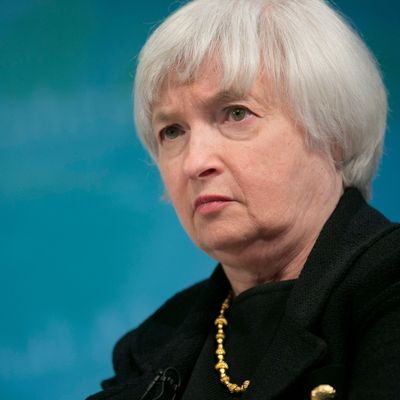
It is a very big very little deal: Today, the Federal Reserve announced that it is raising interest rates by 0.25 percent.
Why is it a little deal? That’s just a quarter of a percentage point — not enough to raise mortgage rates dramatically, or to throw too big of a wrench into the economy. And Janet Yellen has gone to extraordinary pains to eradicate any semblance of confusion or surprise about the rate hike, giving financial actors plenty of time to price it in. So why is it a big deal? It is the first time that the Fed has been able to raise rates in nearly a decade, since mid-2006. It is a sign that the central bank believes the economy is finally strong enough that it can move away from the zero interest-rate policy it has held for years now. And there’s something more: There’s good evidence that what the Fed is doing might be a big little mistake.
To understand why, it helps to think back to the Federal Reserve’s dual mandate, to try to nudge the economy toward “maximum employment” while maintaining “price stability.” In English, that roughly means to get as many people working as possible while keeping inflation around 2 percent.
How’s it doing on that first mandate? Well, the unemployment rate is all the way down at 5 percent, and job growth is fairly robust. But millions and millions of prime-working-age adults are not even looking for a gig. The employment-population ratio is just above 59 percent, down from 63 percent before the Great Recession hit and nearly 65 percent during the dot-com boom. It is recovering, and the Fed continuing to push on the accelerator would help it recover further. As for the second mandate, well, the Fed is not exactly looking great there either. For the past few years, the central bank has targeted a 2 percent rate, discounting volatile food and energy prices. It has repeatedly failed to hit that 2 percent rate, with inflation languishing well below it. Why? There are a lot of factors, but one main one is that the labor market has not yet gotten tight enough for businesses to increase wages for workers. There’s just a lot of slack left in the system.
So why raise interest rates now? The unsatisfying answer is that the Fed just really wants to. It thinks the economy is strong enough to take the hit, which it is. (Raising interest rates will encourage a little more saving and a little less investing. But the 0.25 hike will be too small to make much of a dent.) And it wants to be able to raise interest rates slowly, so that if worrisome signs of inflation do crop up in the future, it won’t have to slam the brakes too hard. “We must also take into account the well-documented lags in the effects of monetary policy,” Yellen explained in a speech this month. “Were the FOMC to delay the start of policy normalization for too long, we would likely end up having to tighten policy relatively abruptly to keep the economy from significantly overshooting both of our goals. Such an abrupt tightening would risk disrupting financial markets and perhaps even inadvertently push the economy into recession.” There’s also the argument that this massively long spell of unusually low interest rates is blowing bubbles that are better deflated sooner rather than later, and that they are allowing for the mis-pricing of credit risk.
But here’s the thing. Let’s say that the Fed were to have stayed its hand, leaving interest rates near zero. In a few months, inflation did spike up to 2.5 or 3 percent, as the low jobless rate forces employers to bid workers’ pay rates up, and the Fed saw much clearer signs of the economy overheating. At that point, it would have essentially unlimited capacity to cool American growth off. All it would need to do is bump rates higher, as much and as quickly as it found prudent. This is the scenario it is trying to ward off: a pretty manageable and not especially scary one. And in doing so, it is choking off growth that could finally mean meaningful wage increases, substantial improvement in the jobless rates for workers with lower educational attainment, and hundreds of thousands of adults re-joining the labor force.
Moreover, there are a few signs that the economy itself is starting to sour: rising haircuts on certain types of corporate debt, pessimism among managers and executives, losses at high-risk financial institutions, any number of problems overseas. The Fed could be back to its zero interest-rate policy soon anyway. And giving itself space to cut rates in the future is not really an argument for raising rates now. “Contractionary policy is contractionary,” argues Larry Summers, among others.
Given all that, why are Yellen and her colleagues still so eager to raise rates? Well, central bankers tend to be temperamentally conservative, and many within the Fed have been pushing for a normalization of policy for its own sake for years. Yellen might see the downside risks of a rate hike more dimly than others do, given that growth is pretty strong right now. It’s not the biggest deal, the 0.25-point hike. But if the economy falls apart soon, it might not look like a small decision either.





























